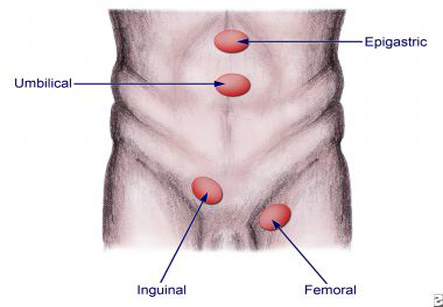Abdominal Hernia
Introduction
A hernia is a condition that arises when an organ pushes through a weak area in the muscles or tissues that surround and contain it.
An abdominal hernia occurs when there is a weakness in the inner lining of the abdominal wall (the outer layer of muscle, fat and tissue that extends from the bottom of the ribs to the top of the thighs).This causes a bulge in the abdominal wall where the organs protrude. The bulge due to the organ can either be pushed back in the abdomen by slight pressure (reducible hernia) or cannot be pushed back (non-reducible).
Hernias are repaired surgically with a simple surgical procedure. If surgery is not performed, this can lead to strangulation. In this condition, the organ or intestine protruding through the abdominal wall may lose its blood supply and die if it becomes tightly trapped. Strangulation of intestine causes extreme pain, can block digestion and may even cause gangrene of that area of intestine. In this case, emergency surgical repair becomes necessary.
A hernia can develop in anyone, from a newborn baby to a senior citizen

Risk factors for Abdominal Hernia:
A hernia can develop in anyone, from a newborn baby to a senior citizen. The following may increase the risk of a hernia by increasing pressure on the abdominal wall:
1. Chronic cough, such as smoker’s cough
2. Obesity
3. Straining during bowel movements or while urinating
4. Pregnancy
5. Lifting heavy objects
6. Persistent sneezing, such as that caused by allergy
Types of Abdominal Hernias
The following are different types of abdominal hernia:
Inguinal Hernia:
A naturally weakened area is formed in the abdominal wall of males due to descent of testicles into the scrotum. This area is called the internal ring, into which the intestine can drop down and can extend down into the scrotum in men. An inguinal hernia can also be the result of an inherited weakness at the internal ring.
Epigastric Hernia:
This type of hernia occurs as a result of a weakness in the muscles of the upper-middle abdomen, above the navel. This hernia occurs commonly in males between 20 and 50 years of age.
Umbilical Hernia:
For repairing the hernia, the surgeon inserts a synthetic mesh behind the weakened abdominal wall.
Naval is also a natural area of weakness in the abdomen which is made up of tissue that is thinner than that in the rest of the abdomen. These hernias can occur in babies, children and adults.
Femoral Hernia:
This hernia occurs in the area between the abdomen and the thigh, and it is more common in women than men.
Incisional Hernia:
This hernia occurs at the site of an incision from a previous surgery. The fat or tissue pushes through a weakness created by the surgical scar.
Symptoms:
Hernia can cause variety of symptoms which may include:
1. A bulge somewhere in the abdomen or pelvic area or in the scrotum for men. This bulge may be reducible on lying down and enlarges when the person is standing.
2. Sharp or dull pain that worsens when having a bowel movement, during urination, or while lifting a heavy object.
3. In case of a strangulated hernia that contains intestine, there may be blood in the stool, constipation, fever, severe pain, vomiting and even shock. This requires emergency surgery.
The doctor usually performs a physical examination and discusses the patient’s symptoms and medical history to determine if a hernia has developed.
Treatment:
Goal of the hernia repair surgery is ending discomfort, repair of the hernia, and stopping the hernia from progressing and complicating.
Usually the hernia repair is performed by laparoscopic surgery in which a fiber optic viewing tube and special instruments are used without making a large incision. This procedure requires less recovery time than traditional hernia repair surgery. One incision is usually taken in the naval area and one on each side of the abdomen just above the waistline. The surgery results in scars of about 10 mm in length, which fade in time.
In some complicated cases or for large hernias, open surgery is required which involves a large incision and more recovery time after surgery. All hernias cannot be corrected by laparoscopic surgery.
Both types of surgeries are usually performed under general anesthesia, which means the patient is asleep during the procedure.
During surgery, the surgeon makes an incision at the hernia and either moves the contents within the hernia back into the abdominal cavity or remove the contents. For repairing the hernia, the surgeon inserts a synthetic mesh behind the weakened abdominal wall. In time the synthetic mesh incorporates in the weakened tissue forming a strong barrier, which prevents reoccurrence of the condition. The repair is permanent and usually does not require any further surgery.